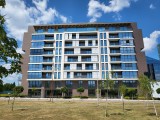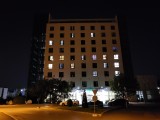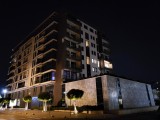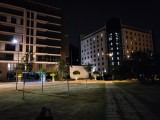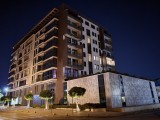Samsung Galaxy Z Flip4 review

Still a dual camera on the back, but with an improved primary
The Samsung Galaxy Z Flip4 features a dual camera setup on its back and a single selfie camera within a small perforation on the foldable screen. All three cameras are the same as on the Flip3 - a 12MP primary, a 12MP ultrawide cams on the outside, and a 10MP shooter on the inside. There is an upgrade, though - the primary camera now features a larger sensor with a different lens.

The primary camera on the Galaxy Z Flip4 uses a Samsung S5K2LD 12MP sensor, behind a 24mm f/1.8 lens. This is the same sensor that was behind the primaries on the Galaxy S20 and Galaxy S21 phones. It has large 1.8µm pixels, adding up to a 1/1.76" sensor. Quite a decent upgrade over the last generation's 1.4µm pixels and type 1/2.55" sensor. And in terms of other extras, the sensor still has Dual Pixel PDAF tech, while the lens is also stabilized.
The ultrawide relies on the same 13MP Sony IMX258 sensor as the Flip3, a Type 1/3.06" unit with 1.12µm pixels, but the phone still outputs 12MP photos. The fixed-focus lens has a reported 13mm equivalent focal length and an f/2.2 aperture.
The inner selfie camera is based on the 10MP Samsung S5K3J1 sensor, which is also taken from the Galaxy S20 series. It is a 1/3" sensor with 1.22µm pixels and sits behind a 25mm f/2.4 lens. The focus is fixed.

The camera app on the Flip4 is, for the most part, identical to what you'd get with any other recent Samsung phone, but with a few tweaks to make use of the Flip4's unorthodox form-factor. The basics are as usual - swiping left and right will switch between available modes, and there's an option to re-arrange, add or remove some of the modes from the viewfinder. Vertical swipes in either direction will switch between front and rear cameras.
There are two zoom control on the viewfinder - 0.5x and 1x. You could zoom in with a pinch gesture, at which point additional preset zoom levels appear at 2x, 4x, and 10x.
The viewfinder has the standard set of icons with the settings cog wheel located in the upper left corner of the screen. The usual stuff like grid lines, location data, etc., can be found in the menu. A Flip exclusive, there's a tiny icon in the far top right corner to activate the cover display for viewfinder purposes, whether it's for your own personal use or your subject's.
There's a Pro mode, and it's still the full-featured variant with control over ISO (50-3200), shutter speed (1/12000s-30s, or up to 0.5s for the ultrawide), manual focus (with peaking), and white balance (by light temperature, with icons next to the number corresponding to a common light source). Metering mode and AF area options are available, too, as well as a set of picture controls for contrast, saturation, and whatnot. A live histogram, as usual, is nowhere to be found.
A key Flip4-specific bit is the ability to have the viewfinder in either half of the display.

Particularly useful is the option to move it to the bottom section and use the half-folded phone for waist-level or above your head shooting.
With the phone folded closed, you can launch the camera with a double press on the power button and use the cover screen as a viewfinder. Sideswipes switch between stills and video while swiping up or down toggles between the main and the ultrawide cameras. The only catch is that the display has a landscape orientation as opposed to both sensors' portrait placement.

Samsung chose to fill the screen completely by taking a center crop from the sensors, making the display not that useful for accurate framing. But if accurate framing is important for you, the Flip4 now supports full view - just double tap on this small screen and the UI will zoom out and show you the whole frame, albeit in a small thumbnail preview.
The other peculiarity from the Flip3, where the images and videos had a square aspect ratio, is now optional. The rear cameras now shoot in proper aspect (4:3 for photos, 16:9 for videos), but you can bring back the crop shooting if that's your thing.
Photo quality
The 12MP photos from the main camera we shot in broad daylight are outstanding - there is plenty of resolved detail and low noise. The processing is competent, and it delivers a balanced and natural look across all photos.
The contrast is great, and the dynamic range is good but not over the top as the Auto HDR isn't hell-bent on brightening every shadow. Finally, the colors are Samsungly vivid, but luckily - not to extremes.
The main camera's larger sensor on the Flip4 shows an improvement over the Flip3 in the daylight performance. The Flip4 foliage (trees, grass) looks more detailed and better defined. The difference isn't major, but it is noticeable.
The 12MP photos from the ultrawide camera are quite likable. They are surprisingly detailed for such type of camera/lens combo, and the per-pixel sharpness is satisfying even if not a match to the primary shooter.
The automatic distortion correction is good though the corners are not as sharp as the center - something that's expected from such ultrawide-angle cameras.
The rest - colors, contrast and dynamic range - is a match to the primary camera performance a.k.a. excellent across the board.
The portrait mode on the main camera delivers superb portrait shots with incredibly detailed subjects, well-exposed and colorful. The background separation is notably proficient, and the blur is very pleasant and colorful.
Thanks to the external display, the rear camera can and should be used for selfie purposes as it offers autofocus, higher resolution, OIS and better sensors.
So, the 12MP selfies we shot with the primary camera are absolutely lovely - the subjects are incredibly sharp, the dynamic range is great, contrast and colors - lovely. Thanks to the f/1.8 aperture - there is no need do simulate blur, as you will get natural bokeh for these shots. We think this is the best way to shoot selfies with the Flip4.
If you need to blur the background even more, you can always enable the portrait mode. It does an impressive job, as we already established.




Portrait selfies with main camera
And, of course, ultrawide-angle selfies are possible if you need to take a group shot. Just be sure to hold the phone as far as possible, otherwise, your subjects will be out of focus.
And here are some actual 10MP selfies from the inner camera. They are quite good, too, with excellent detail for such a camera, proper exposure, low noise levels, and likable dynamic. The contrast is lovely, as long as you keep the lens clean.
The per-pixel sharpness here is not on par with the primary rear camera, of course, but still a lot better than on many other phones, nevertheless.
We took a few portrait selfies with the inner camera, and they are great across the board - exposure, subject separation, detail, colors.




Portrait selfies, 10MP inner camera
Let's look at some low-light photos now.
The Galaxy Z Flip4 offers Auto Night Mode as part of the default Photo mode. You can decide to ignore it by tapping on the small Moon icon or leave it be. The first batch of shots were shot with Auto Night Mode, and they are quite pleasing. There is enough detail, the noise reduction has done a good job in cleaning noise, and the dynamic range is pretty good.
The exposure is great across the scenes, even if the algorithm makes for brighter than reality photos. The color saturation is superb.
The photos we took without Night Mode are still plenty good - they have more blown highlights than the Night Mode ones, but Auto HDR is still at play, so it's a rather minor difference. The images are still incredibly detailed, with more realistic exposure, brightness, and deeper shadows.
The color saturation is still excellent, and so is the contrast. If you prefer a more realistic look, we suggest disabling the Night Mode and shooting this way.
Finally, we forced the Night Mode and noticed that sometimes it adds a second or two to the exposure times, meaning some of these took a bit longer to shoot. Scrolling through this batch of photos we found they have little to no difference from the ones we shot at Auto Night Mode.
The promised boost in low-light performance since the Flip3 is quite obvious when we compare Flip4 and Flip3 photos side by side. The ones taken with the Flip4 are sharper and cleaner, with more visible detail, less noise and slightly better colors.
The difference when using Night Mode is barely there - the Flip4 offers a different take on the colors, but only the fourth photo has a slight boost in sharpness.
The Auto Night Mode works on the ultrawide camera, too. It saves bright photos with good dynamic range, bright skies, and pleasant color saturation. The Auto HDR helps a lot, too.
The ultrawide camera at night doesn't impress with resolved detail, and the noise reduction has further smeared even more fine detail, and it could also be responsible for visible image artifacts. At the end, we got usable photos, but with subpar detail and soft corners.
While the ultrawide images aren't that good at 100% zoom, they will impress at lower resolution when shared across social networks.
The Auto Night Mode makes for quite bright UW photos. If those are not your cup of tea, you should disable it and enjoy more realistic exposure and dynamic range. The resolved detail and the color saturation do take a hit, though.
Just like with the primary camera, the ultrawide offers a standalone Night Mode, which often uses longer exposure times but delivers simar photos to the default Auto ones.
And here are photos of our usual posters taken with the Galaxy Z Flip4 - you can clearly see the improvement in low-light conditions over the Flip3. You can see how it stacks up against the competition. Feel free to browse and pit it against other phones from our extensive database.



Galaxy Z Flip4 against the Galaxy Z Flip3 and the Galaxy S22 Ultra in our Photo compare tool
Video quality
The Galaxy Z Flip4 captures videos with all its cameras. The main camera record videos up to 4K at 60fps, and there's 1080p at both 30fps and 60fps. The ultrawide and selfie shooters max out at 4K at 30fps.
Optical stabilization is available on the primary camera, while electronic stabilization can be enabled/disabled for all three cameras. If enabled, it does an outstanding job at stabilizing the footage at the expense of a bit lower FoV and a slight drop in the sharpness.
The 4K footage gets 48Mbps video bitrate when using the h.264 codec. The audio bitrate is about 256kbps. The sound is stereo.
The 4K clip we shot with the main camera is excellent - the resolved detail is a lot, the colors are true to life, contrast is excellent, while the dynamic range is good but not over the top. We liked the processing - foliage, buildings, people - they all look natural.
The 4K videos from the ultrawide camera are solid - they also offer plenty of detail; the colors, contrast and dynamic range match the main camera's - something that is often neglected. The corners are a bit soft, but that's unavoidable with a 13mm aperture lens. Overall, the 4K clips from the UW camera are great.
The primary camera offers good low-light videos even if a bit noisy. The footage has enough detail, the colors are nicely saturated, while the exposure is realistic.
Finally, here is the Galaxy Z Flip4 in our video tool so you can make your own comparisons.



2160p: Galaxy Z Flip4 against the Galaxy Z Flip3 and the Galaxy S22 Ultra in our Video compare tool
Reader comments
- Matt
- 23 Oct 2024
- Nv$
this is the worst of the samsungs i have ever used 6 months down the road and the screen shuts down as if the fibre is spoilt. i dont even know how to repair it. i cannot access anything on the main screen. can only receive calls at the front screen....
- Sunil Kumar Dube
- 13 Sep 2024
- X%e
I purchased Samsung Z Flip 4 on 13th January 2023 with one year warranty. As soon as this warranty period over,trouble in this set started. This phone gets switched off as soon as this phone is folded. Again it is to be switched on and has to restart...
- Umang
- 03 Jul 2024
- XVW
Yes i agree in last 2 years I have almost paid the cost price in repairs. Worst buy ever. Battery back up after 2 years is 6 hours

























